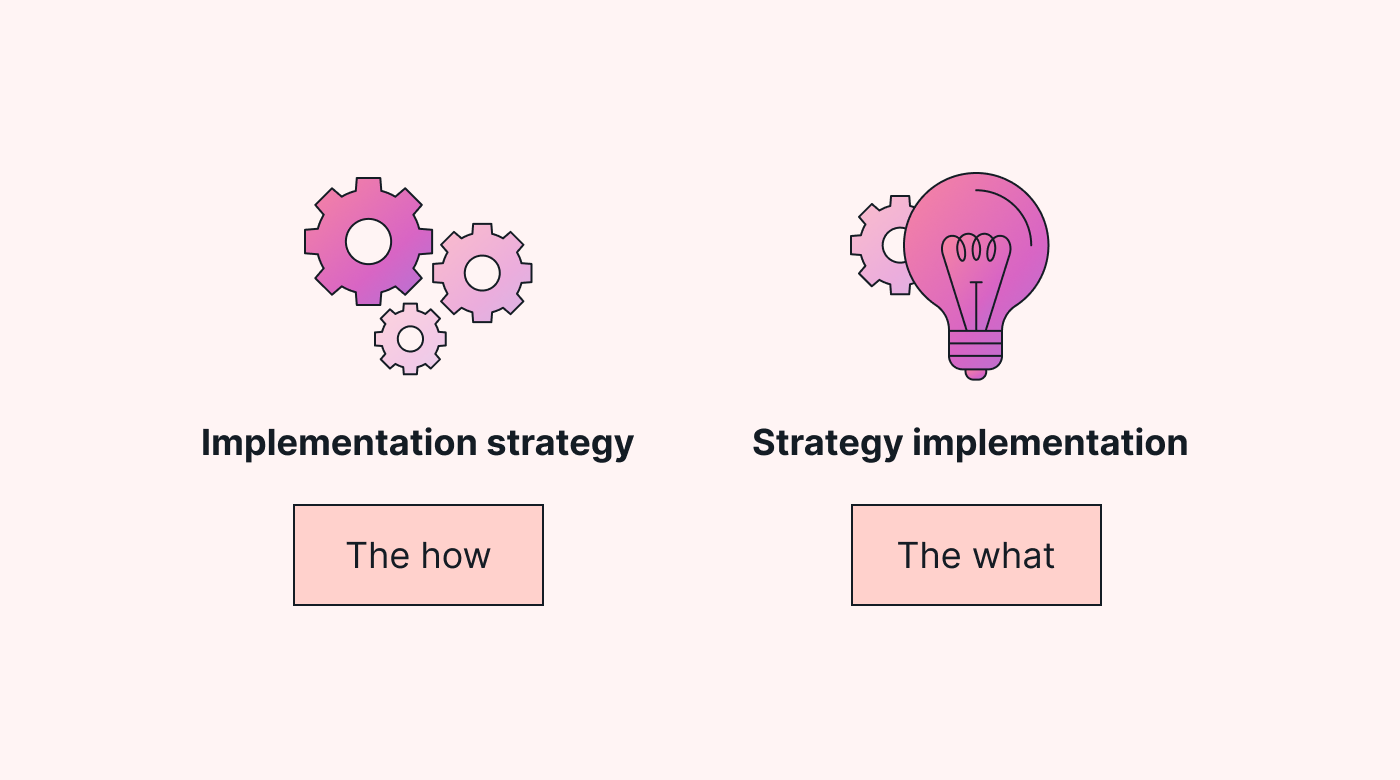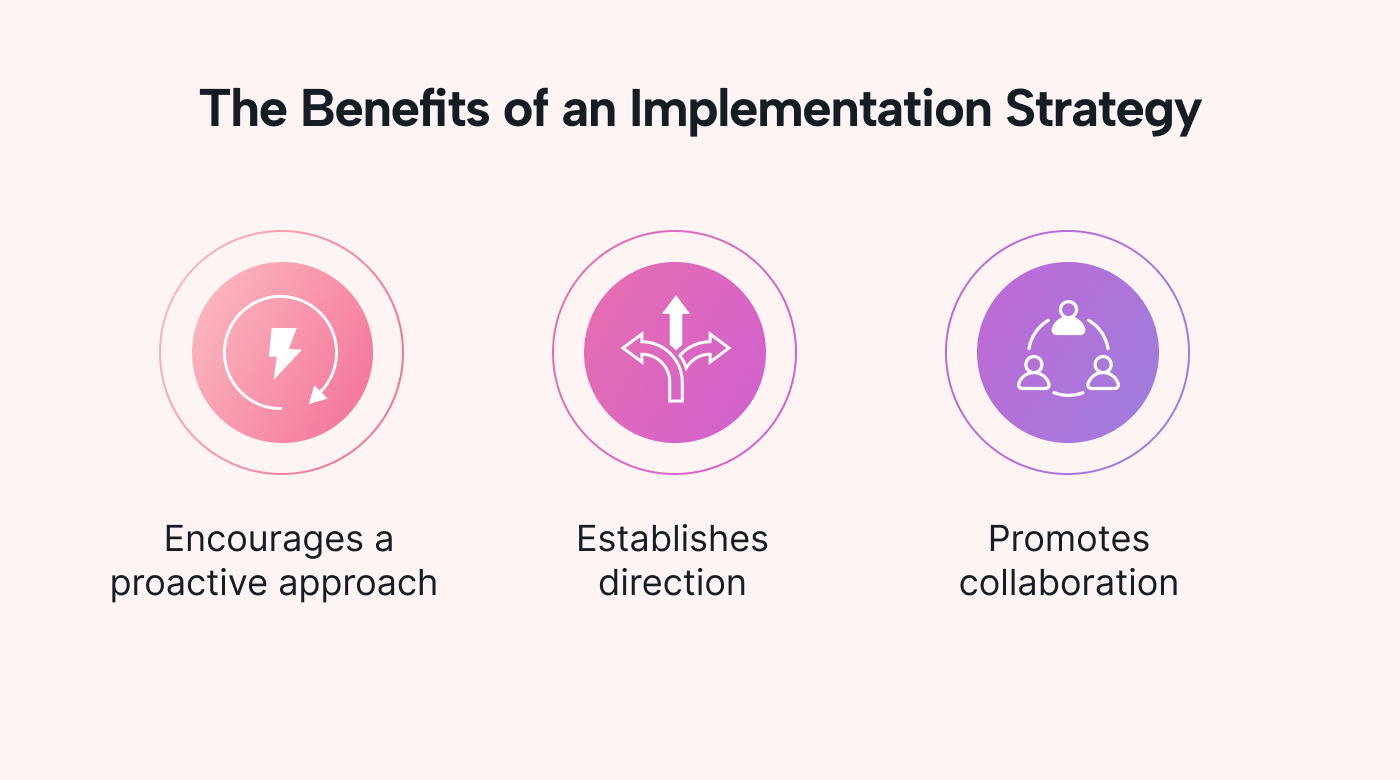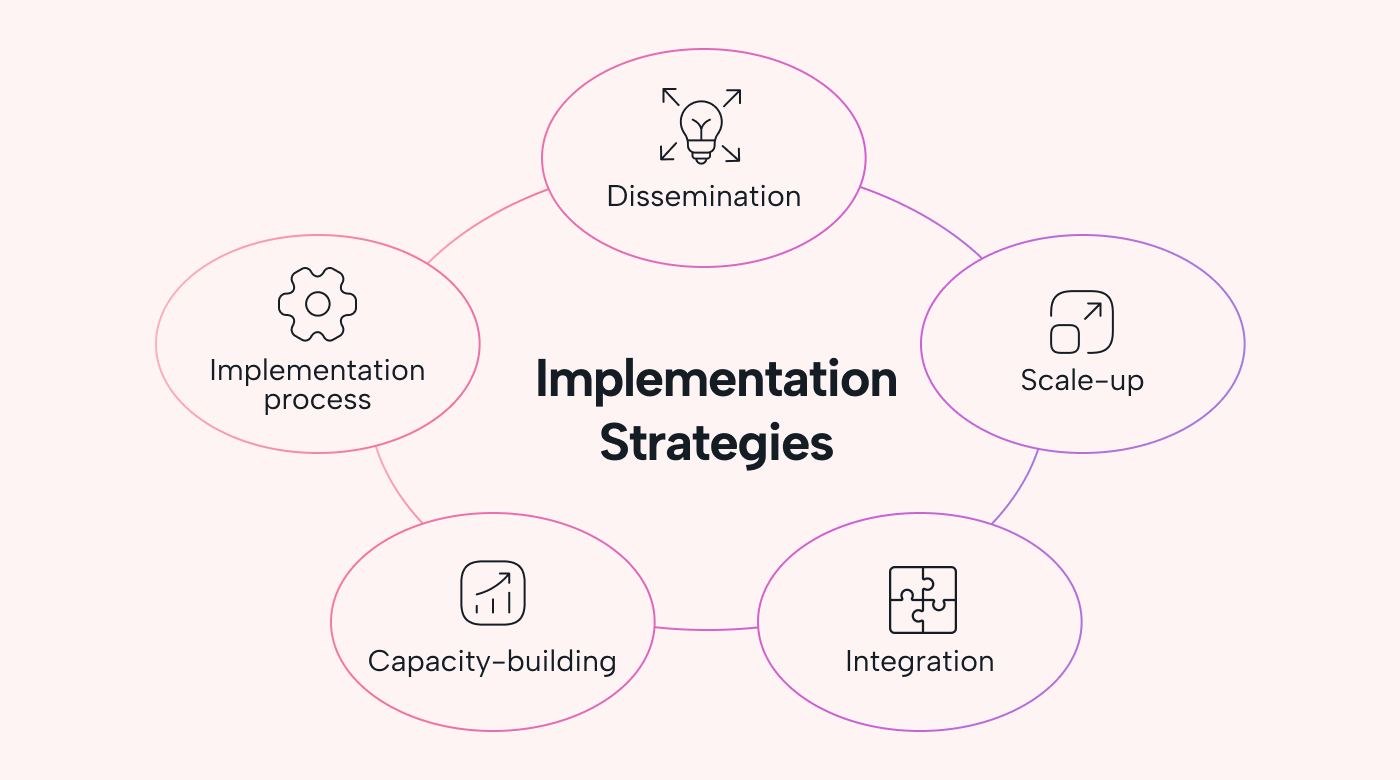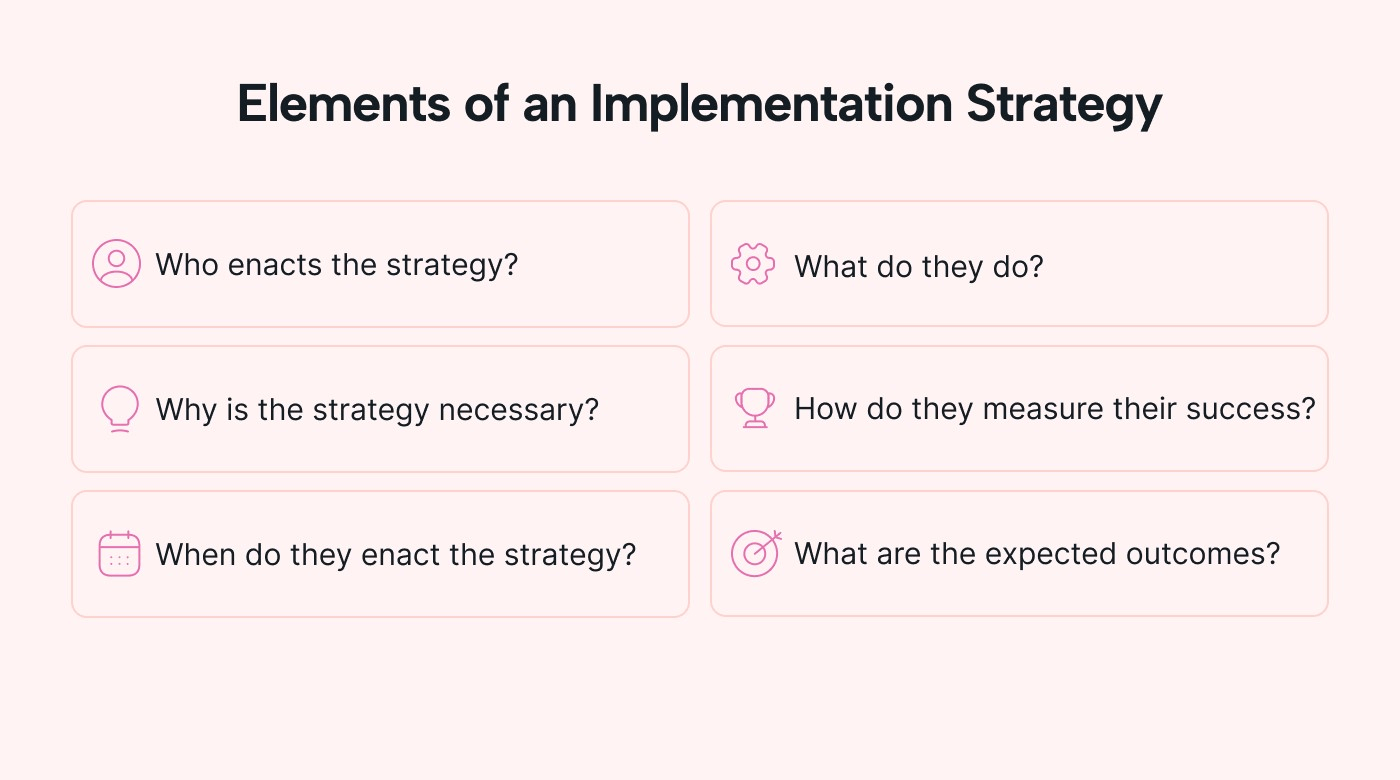Having a plan is great.
But having the skills and know-how to follow that plan effectively is even better.
All managers are familiar with the frustration of not knowing how to go about implementing change in their teams. You’re supposed to help the process move as quickly as possible, but you’re also supposed to keep production levels and employee satisfaction high.
If this sounds like an impossible task, then you need to adopt an implementation strategy.
In this article, we explore what implementation strategies are, explain how they facilitate change, and teach you the best strategies to incorporate into your processes.
What is an implementation strategy?
An implementation strategy is a technique or method you follow while executing a plan or implementing a change. They guide and inform your actions, explaining how each member of your company should behave as you all work toward a common goal.
Outlining an implementation strategy is useful whenever a company or team is about to work on a new project or shift to a new system, as it helps make the execution as smooth, efficient, and painless as possible.
When your teams have an implementation strategy, they know how to react to likely problems, can follow the correct communication channels, and are more likely to communicate and collaborate effectively as they put the plan into action.
What’s the difference between strategy implementation and an implementation strategy?
Although they sound indistinguishable, these terms refer to slightly different ideas.
- Strategy implementation is the act of execution itself.
- An implementation strategy is a technique or action that assists with the execution of a plan.
An easy way to separate the two is to think of strategy implementation as your what and your implementation strategy as your how.
 |
For example, if your strategy implementation is the act of running a marathon, your implementation strategy would be to wear suitable running shoes and maintain an eight-minute mile pace.
Why is an implementation strategy important?
Your plan is only as good as its execution.
When you focus on how you’re behaving while following a step-by-step plan, you’re more likely to avoid common mistakes and reach your desired outcome without issues.
 |
Having an implementation strategy in place can help your business in the following ways:
It encourages a proactive approach
Taking a proactive approach means anticipating potential hiccups so you can:
- Prevent these issues from happening
- Outline what employees should do if a problem arises
Implementation strategies often include contingency plans that explain how to respond to various scenarios and take corrective action. These steps help managers and team members by giving them clarity on the appropriate way to act when something doesn’t go according to plan or when there’s a clear need to pivot.
It establishes direction for teams
Implementation strategies establish required actions to reach a desired business outcome. They affirm your company values and comply with the mission statement to keep your teams on the right path.
Implementation strategies also help teams make quicker decisions throughout the execution process since they know what they’re supposed to prioritize.
It promotes collaboration and teamwork
When an employee has clearly defined methods to cope with change, they’ll have an easier time communicating their needs with the rest of their team. Implementation strategies encourage businesses to facilitate communication and idea-sharing, both of which make effective teamwork possible.
Implementation strategies also promote collaboration among vendors, customers, and key stakeholders. These individuals’ opinions can help shape your service offerings by giving you an outside perspective on the value your company provides.
Types of implementation strategies
The goal of any implementation strategy is to make the process as smooth as possible for everyone involved. Implementation strategies consider everyone’s needs and abilities and help to keep the company united through seasons of uncertainty.
As a business owner, manager, or team leader, you want to create a company culture that facilitates smooth transitions and growth. Company culture has a significant impact on employees’ readiness to accept change.
Your role is to use implementation strategies to assist your teams and make it easier for them to adapt. But first, you need to decide which type of strategy to use.
There are several approaches you can take when implementing change.
 |
The five most common implementation strategies are as follows:
1. Dissemination strategies
Dissemination refers to the spreading of information widely. Dissemination strategies, therefore, focus on educating employees and stakeholders while they undergo a company-wide change.
Your education methods could include explaining why the company is pursuing the current change, as well as how it will affect or benefit the employees. You could also focus on distributing knowledge or training your employees to help them adapt to a new platform or business process.
You should use this strategy if:
- You’re moving to a new employee management platform. Your employees and HR team will need assistance as they learn the new platform and adapt their processes to fit the new system.
- You’re shifting to a hybrid or remote system. Your entire company needs to adapt to new communication standards and workflows to fit into a hybrid or fully remote setup.
- You’re changing your payment systems. Clients and vendors need to be notified and educated on any updates regarding your payment platforms, terms, or prices.
2. Scale-up strategies
Scale-up strategies focus on increasing the company’s capacity for growth and change. These methods could include upgrading your equipment or expanding your facilities to accommodate company growth.
You should use this strategy if:
- You’re about to hire more employees. Any future employees need to have the space, tools, and facilities that your current employees have. You also want to support your HR department by giving them the resources they need to support and manage a larger workforce.
- You’re expanding the company’s service offerings. This type of expansion often involves bringing on new vendors or external stakeholders. You want to facilitate collaboration with these professionals and then use their knowledge to educate your employees on new roles or expectations.
3. Integration strategies
Integration strategies focus on weaving in new technology or updated standard practices into your company’s existing workflow. These methods could take the form of updating job responsibilities or revising your record-keeping procedures.
Many integration strategies also involve educating or upskilling employees so their knowledge remains relevant and up-to-date.
You should use this strategy if:
- You’re digitizing or automating a procedure. Adopting a new digital platform can take some getting used to. You’ll want to train your employees on how to use new platforms or apps to help them get their work done more efficiently.
- Your industry standards have shifted. Many sectors must integrate new information into their processes to comply with industry standards and ensure their employees are working compliantly and safely. This is often the case for those in the medical industry, where new research is constantly shifting best practices.
 |
4. Capacity-building strategies
Capacity-building strategies focus on expanding your employees’ capacity for updates and change. These methods build motivation for employees to go along with implementation efforts and help them shed any concern or resistance they have regarding a change.
Many capacity-building initiatives include opportunities for employees to get involved with testing or providing employee feedback.
You should use this strategy if:
- You’re about to make any company-wide change. Find out from your employees if there’s anything you could do to help them smoothly move through the upcoming season of change. By gathering their opinions, you boost transparency and help prepare them for the transition.
- You’re about to change your company’s standard workflow. Your employees often have deeper insights into smaller workflows than you do. If you’re considering updating your standard operating procedure, give your employees a chance to talk about any inefficiencies or pain points they’d like you to address.
5. Implementation process strategies
Implementation process strategies focus on monitoring the execution of a plan and addressing any issues that come up during the strategy implementation. These methods are more reactive than other strategies because many of their solutions are only found after something’s gone wrong.
Monitoring strategies involve analyzing the starting point and progress of the plan’s execution, gathering feedback throughout the process, and making any necessary adjustments to keep the process smooth. These strategies allow senior management to make important interventions over time, which help align your employees’ actions with the project goals.
You should use this strategy if:
- You’re executing a plan. Monitoring strategies are the most important type of implementation strategy and should always be part of your process!
Key components of an implementation strategy
When designing an implementation strategy, you want to build something that’s robust and easy to understand. Creating thorough and strategic plans that anyone in your company can follow means you’ll be much less likely to encounter roadblocks down the line.
 |
The key elements of an implementation strategy answer the following questions:
- Who enacts the strategy, and who will be impacted by the upcoming change? You need to know exactly which departments and teams are involved so you can prepare these groups for change and inform each person of their role during the implementation phase.
- Why is the strategy necessary? Here, you could connect to your company’s mission statement or explain which pain points or inefficiencies the change will address. This education combats fear and hesitancy among the employees and gives them the ability to embrace the change with enthusiasm.
- When do they enact the strategy? Inform your teams when certain behaviors are necessary and appropriate throughout the implementation plan. You can also outline the time frame for the entire strategy implementation process.
- What do they do, and how do they behave? Here, you’ll outline each employee’s role and responsibilities during the strategy’s implementation. Outline an action plan with easy-to-follow steps for different departments and teams to use.
- How do they measure their success? Explain to your team members how they can tell if they’ve been successful at every step of the process. You could describe key performance indicators, project objectives, strategic objectives, or any other markers you’ll be looking for during the performance management.
- What are the expected outcomes? Here, you’ll explain the long-term goal your company is aiming for by implementing the change.
The role of leadership in any strategic implementation
When a company goes through a season of change, whether they’re introducing new strategic goals, expanding their service areas, or changing their management teams, it’s the leadership’s responsibility to guide the employees through that change.
Leaders choose and shape the implementation strategy that enables the company to adjust to changes with ease.
 |
Key responsibilities of a manager in times of change include the following:
Providing direction
If you want to keep your employees engaged, you need to align their work with the company’s overarching goals, values, or mission.
Transformational leadership has a significant impact on creating intrinsic motivation (and therefore improving work performance) in employees. Essentially, leaders have the opportunity to guide, motivate, encourage, and inspire their employees to perform at their best.
Facilitating communication
Communication and collaboration are the backbone of an efficient company. As a leader, it’s your job to encourage and facilitate internal team communication, cross-team communication, and communication between employees and higher-ups.
Related: 10 Strategies for Unlocking the Power of Team Collaboration
Helping employees adapt to change
Change is scary, and it’s your job to remove intimidation for your employees and help them become comfortable with new systems and processes.
For example, let’s say your latest business strategy is to automate planning and scheduling by using Motion’s team calendar. You can make this transition simpler for your team members by demonstrating how to use the platform and making yourself available for assistance when needed.
Relaying employee feedback
Provide opportunities for your employees to speak about how they’re responding to the change, what could improve their experience, and how the company could better support them. This will help them stay happy and productive.
Related: Mastering Manager Responsibilities: The Ultimate 2023 Guide
Execute your plans flawlessly with Motion
You should now know what implementation strategies are and how you can use them to transform your leadership style.
Successful implementation strategies introduce simple shifts to your processes and leave a lasting impact on your team. Additionally, allowing your employees to form an integral part of your company’s processes helps create a culture of collaboration.
Motion’s team calendar makes collaboration a breeze. At the beginning of each work day, it automatically assigns tasks to your employees, schedules meetings when all employees are available, and creates personalized schedules for employees to follow. With Motion, you can easily see what your employees are working on and keep track of any deadlines they need to meet.
If you’re ready to give Motion for Teams a try, get started with our 7-day free trial.





